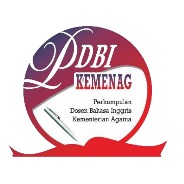ICT and Learning Attitude towards Students’ Academic Paragraph Writing in College Level
Abstract
The use of technology has been growing rapidly in recent years. The technology applies to support the success of language learning, for example, providing web-based learning, mobile-based learning, educational videos, stimulation, online learning platforms, and many more. Learning attitude also determines to achieve the language learning goals. Then, the complexity of English writing causes the students’ denial to take English writing classes. This study aimed at finding out whether there was a significant correlation among ICT writing. Seventy-one students of the English Education Study Program got involved in this correlational study. The data were gained from primary and secondary sources; those are a 15-item ICT use questionnaire, a 20-item learning attitude questionnaire, and documentation of students’ writing. The findings reported that there was a significant correlation among the three variables statistically since the significant value was 0.006 (< 0.05). The value of adjusted r2 was 0.114 which means ICT use and learning attitude contributed 11.4 % to the students’ English academic paragraph writing.
Key words: ICT, learning attitude, academic paragraph writing
Keywords
Full Text:
PDFReferences
Apriani, E. (2016). A New Literacy: The role of technology to develop student’s character. Ta’dib: Journal of Islamic Education (Jurnal Pendidikan Islam), 21(1), 59-72.
Apriani, E. (2017). THE MISUSE OF ICT BY STUDENTS: THE EFFECTS OF PHORNOGRAPHY AND THE TEACHER SOLUTIONS. Tadrib, 1(2), 185-203. Retrieved from http://jurnal.radenfatah.ac.id/index.php/Tadrib/article/view/1046.
Apriani, E., & Hidayah, J. (2019). The ICT Used by the English Lecturers for Non-English Study Program Students at IAIN Curup. Vision: Journal for Language and Foreign Language Learning, 8(1), 26-37.
Apriani, E., Supardan, D., Sartika, E., Suparjo, S., & Hakim, I. N. (2019). Utilizing ICT to develop student’s language ethic at Islamic university. POTENSIA: Jurnal Kependidikan Islam, 5(1), 1- 14.
Apriani, E. (2017). Utilizing Preservice English Teachers Strategies and Classroom Management at Junior High School in Rejang Lebong Regency. ENGLISH FRANCA: Academic Journal of English Language and Education, 1(2), 149-194.
Abas, I.H. and Aziz, N.H.A. (2016). Indonesian EFL students’ perspective on writing process: A Pilot Study. Advances in Language and Literary Studies, 7 (3).
Ajzen, I. (2005). Attitude, personality and behavior (2nd ed.). New York, NY: Open University Press.
Apriani, E. (2016). A New Literacy: The role of technology to develop student’s character. Ta'dib: Jurnal Pendidikan Islam, 21(1), 59-72.
Apriani, E., Inderawati, R., Arianti, A., Wati, S., & Hakim, I. N. (2021). Implementing E-learning Training toward English Virtual Lecturers: The Process, Perspectives, Challenges and Solutions. International Journal of Emerging Technologies in Learning, 16(4).
Aryanika, S. (2016). The correlation between the students’ writing motivation and the writing ability. English Education: Jurnal Tadris Bahasa Inggris, 9(1), 2016, 215-232.
Ariyanti. (2016). The teaching of EFL writing in Indonesia. Dinamika Ilmu, 16 (2), 2016.
Aunurrahman., Hamied, F.A., & Emilia, E. (2016). Exploring an academic writing class in an Indonesian university Context. Language Circle: Journal of Language and Literature, 11, 1-11.
Bidin, S. (2009). Motivation and attitude in learning English among students in the northern region of Malaysia. Journal of English Language Teaching
Brown, H. D. (2001). Teaching by principles. New York, NY: Addison Wesley Longman, Inc.
Choy, S. C., & Troudi, S. (2006). An investigation into the changes in perceptions of and attitudes towards learning English in a Malaysian college. International Journal of Teaching and Learning in Higher Education, 18(2), 120–130.
Creswell, J. W. (2005) . Educational research: Planning, conducting, and evaluating quantitative and qualitative research (2th ed.). Boston, MA: Pearson Education, Inc.
Creswell, J. (2009). Research design: Qualitative, quantitative and mixed approaches (3rd Ed). Thousand Oaks, CA: Sage Publications, Inc.
Creswell, J. (2012). Educational research planning, conducting, and evaluating quantitative and qualitative research (3rd ed.). Upper Saddle River, NJ: Pearson Education, Inc.
Daniels, P.T. & Bright, W. (1996). The study of writing systems. London, UK: Oxford University Press, Inc.
Dehbozorgi, E. (2012). Effect of attitude towards language earning and risk-taking on EFL students’ proficiency. International Journal of English Linguistics, 2, 41–48. doi:10.5539/ijel.v2n2p41.
Dudeney, G. (2000). The internet and the language classroom. Cambridge: Cambridge University Press.
Fajri, H, M., Inderawati, R. & Mirizon, S. (2015). The implementation of peer editing technique to improve writing achievement. The Journal of English Literacy Education: The Teaching and Learning of English as a Foreign Language. 2 (2), 48-57.
Feng. R., & Chen, H. (2009). An analysis on the importance of motivation and strategy in postgraduates English acquisition. English Language Teaching, 2, 93–97.
Finger, G., & Trinidad, S. (2002). ICTs for learning: An overview of systemic initiatives in the Australian states and territories: Australian Educational Computing, 17(2), 3-14.
Graham, S., Berninger, V., & Fan, W. (2007). The Structural Relationship between Writing Attitude and Writing Achievement in First and Third Grade Students. Contemporary Educational Psychology, 32, 516-536.
Hashemian, M., & Heidari, A. (2013). The Relationship between L2 Learners’ Motivation/Attitude and Success in L2 Writing. Procedia - Social and Behavioral Sciences, 70, 476–489.
Inderawati, R. (2011). From classroom to peer comment in Facebook: Bridging learners’ literacy. Paper presented in the 4th International Conference ICT for Language Learning. Pixel, Italy.
Inderawati, R. (2017). The dynamics of EFL teaching in Indonesia: Be innovative teachers through social media. English Language Teaching and Research, 1(1), 29-37.
Inderawati, R., Petrus, I. & Jaya, H.P. (2019). Exploring and identifying technology-based dynamic learning through social media in academic writing. English Community Journal, 3 (1): 317–324
Inderawati, R., Sofendi, Purnomo, M. E., Vianty, M., &Suhendi, D. (2019). Students’ engagement in utilizing technology for learning support. ENGLISH FRANCA: Academic Journal of English Language and Education. 3 (2), 181-195
Kara, A. (2009). The effect of a “Learning Theories’ unit of students attitude toward learning. The Australian Journal of Teacher Education. 34(3).
Luo, H. & Lei, J. (2012). Educational stages and interactive learning: From kindergarten to workplace training. 73-91. China: Peking University Press. Retrieved from 10.4018/978-1-4666-0137-6.ch005..
Muslim, I. M., (2012). Helping EFL students improve their writing. International Journal of Humanities and Social Science, 4(2), 105-112.
Nunan, D. (1999). Second language teaching and learning. Boston: Heinle & Heinle Publishers.
Patton, M. (2006). Qualitative research and evaluation methods. Thousands Oaks, CA: Sage Publication, Inc.
Pelgrum, W. J. (2001). Obstacles to the integration of ICT in education: results from a worldwide educational assessment: Computers & Education, 37, 163-178.
Sanjaya, H. K., Apriani, E., & Edy, S. (2020). Using Web Blog for EFL Students in Writing Class. Using Web Blog for EFL Students in Writing Class, 4(04), 516-535.
Selwyn, N. (2003). ICT in non-formal youth and adult education: defining territory. Philadelphia: OECD/NCAL International roundtable Retrieved from http://www.literacy.org/ICTconf/OECD_Selwy n_final.pdf.
Scrivener, J. (2011). Learning teaching: The essential guide to English Language Teaching (3rd Ed). Basingstoke, HPH: MacMillan.
Sicilia, C. (2005). The challenges and benefits to teachers' practices in constructivist learning environments supported by technology. Unpublished master’s thesis, McGill University, Montreal.
Setyowati, L. & Sukmawan, S. (2016). EFL_ Indonesian Students’ Attitude toward Writing in English. Arab World English Journal (AWEJ). 7 (4). 365-378.
Sliwka, A. (2003). Networking for educational innovation: A comparative_analysis. Networks of innovation: Towards new models for managing __ schools and systems, 49-63.
Sujannah, W.D. & Cahyono, B.Y. (2017). The effect of self- selected topic and checklist-based peer feedback on Indonesian EFL students’ writing ability. International Journal of English Language Teaching, 4 (2); 2017.
Tinio, V. (2002). ICT in education. New York, NY: United Nation Development Program.
Toomey, R. (2001). Schooling issues digest no 2: Information and communication technology for teaching and learning. Retrieved from http://www.dest.gov.au/schools/publications/2001/digest/tech
DOI: http://dx.doi.org/10.29240/ef.v5i1.2059
Refbacks
- There are currently no refbacks.
Copyright (c) 2021 Rita Hayati, Hesti Wahyuni Anggraini

This work is licensed under a Creative Commons Attribution-NonCommercial-ShareAlike 4.0 International License.
INDEXED BY:
 This work is licensed under a Creative Commons Attribution-NonCommercial-ShareAlike 4.0 International License
This work is licensed under a Creative Commons Attribution-NonCommercial-ShareAlike 4.0 International License
@ ENGLISH FRANCA : Academic Journal of English Language and Education
Jl. Dr. AK Gani No 1 Dusun Curup, Rejang Lebong Regency, Bengkulu Province, Indonesia, 39119.
Dr. Eka Apriani, M.Pd., email: efranca@iaincurup.ac.id, eka.apriani@iaincurup.ac.id.




.png)












